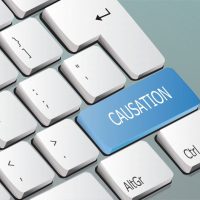Proving Causation in New York Toxic Tort Cases

Toxic tort cases in New York present unique challenges for defendants, particularly when it comes to proving or disputing causation. These cases often involve complex scientific evidence, multiple sources of exposure, and intricate legal standards. For insurance companies and businesses facing toxic tort claims, understanding the nuances of causation is crucial to mounting a successful defense. Read on for a discussion of the issues surrounding proof of causation in New York toxic tort cases. If you are a New York landlord or property owner facing toxic tort litigation, contact the Law Offices of Richard A. Fogel, P.C., to speak with a skilled and experienced New York toxic torts defense attorney.
The Legal Standard for Causation in Toxic Tort Cases
In New York, proving causation in a toxic tort case requires the plaintiff to demonstrate that the defendant’s actions or products were a substantial factor in causing their injury. This involves establishing two critical components: general causation and specific causation.
General Causation
General causation refers to whether the substance in question is capable of causing the type of harm alleged by the plaintiff. For example, in a case involving exposure to asbestos, the plaintiff must show that asbestos exposure can cause the disease they are claiming, such as mesothelioma or lung cancer. This often requires expert testimony and scientific studies that link the substance to the particular health condition.
Specific Causation
Specific causation, on the other hand, focuses on whether the substance actually caused the plaintiff’s injury in the specific circumstances of the case. The plaintiff must prove that their exposure to the toxin, as a result of the defendant’s conduct, was a substantial factor in bringing about their injury. This can be challenging, especially when the plaintiff has had multiple exposures to the same or similar substances from different sources.
Challenges in Proving Causation
Proving causation in toxic tort cases is inherently difficult due to the scientific complexities involved. Several factors can complicate the plaintiff’s ability to establish causation:
- Latency Periods: Many toxic tort cases involve diseases that have long latency periods, meaning the symptoms may not appear until years or even decades after exposure. This makes it difficult to link the injury to a specific exposure or a particular defendant.
- Multiple Exposures: Plaintiffs often have been exposed to the alleged toxic substance in multiple settings, such as at work, at home, or in the environment. Disentangling the effects of different exposures and pinpointing the source of the injury is a significant challenge.
- Scientific Uncertainty: In many cases, the scientific community may not fully understand the mechanisms by which certain substances cause harm. This uncertainty can make it harder for plaintiffs to present conclusive evidence of causation.
- Dose-Response Relationship: Establishing the dose-response relationship—how the amount of exposure relates to the risk of harm—is critical. Plaintiffs must often show that the level of exposure they experienced was sufficient to cause their injury. This can be a high hurdle, particularly if the exposure levels are disputed.
Defense Strategies in Toxic Tort Cases
Given the difficulties plaintiffs face in proving causation, defendants in toxic tort cases have several strategies at their disposal:
Challenging the Plaintiff’s Expert Testimony
Expert testimony is often central to the plaintiff’s case in establishing causation. Defendants can challenge the admissibility and credibility of this testimony by questioning the scientific basis for the expert’s conclusions, highlighting inconsistencies in the expert’s methodology, or presenting counter-experts to dispute the plaintiff’s claims.
Focusing on Alternative Explanations
Defendants can also argue that the plaintiff’s injury could have been caused by other factors, such as exposure to other substances, pre-existing medical conditions, or lifestyle choices. By presenting evidence of alternative causes, defendants can create doubt about whether their actions or products were responsible for the plaintiff’s harm.
Emphasizing the Dose-Response Relationship
A key aspect of causation is the dose-response relationship. Defendants can argue that the plaintiff’s exposure was below the threshold necessary to cause harm, or that the exposure level is not reliably linked to the specific injury claimed. By undermining the connection between the dose and the alleged harm, defendants can weaken the plaintiff’s case.
Contact the Law Offices of Richard A. Fogel, P.C. for Toxic Torts Defense in New York
Proving causation in New York toxic tort cases is a complex and demanding process, requiring plaintiffs to navigate scientific uncertainties, multiple exposures, and long latency periods. For defendants and their insurers, understanding the challenges of causation and employing effective defense strategies is essential to successfully contesting toxic tort claims. At the Law Offices of Richard A. Fogel, P.C., we focus our legal practice on defending against these claims, leveraging our extensive experience and deep knowledge of toxic tort litigation to protect our clients’ interests.
If your business is facing a toxic tort claim, it’s crucial to have experienced legal representation on your side. Call us today at 516-721-7161 to discuss how we can assist you in mounting a robust defense.
